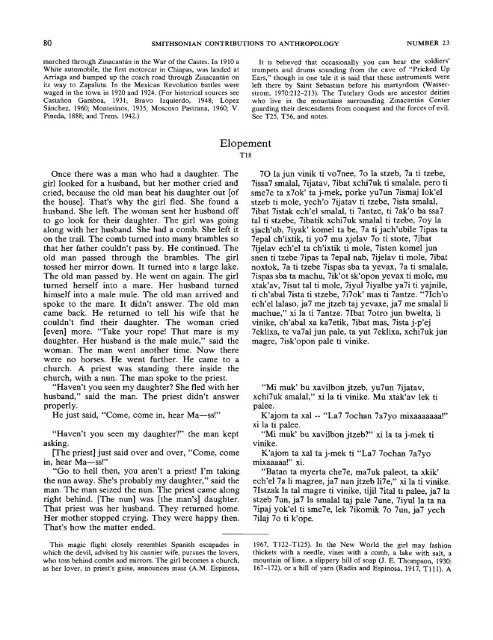PDF (Lo-Res) - Smithsonian Institution Libraries
PDF (Lo-Res) - Smithsonian Institution Libraries
PDF (Lo-Res) - Smithsonian Institution Libraries
Create successful ePaper yourself
Turn your PDF publications into a flip-book with our unique Google optimized e-Paper software.
80 SMITHSONIAN CONTRIBUTIONS TO ANTHROPOLOGY NUMBER 23<br />
marched through Zinacantan in the War of the Castes. In 1910 a<br />
White automobile, the first motorcar in Chiapas, was landed at<br />
Arriaga and bumped up the coach road through Zinacantan on<br />
its way to Zapaluta. In the Mexican Revolution battles were<br />
waged in the town in 1920 and 1924. (For historical sources see<br />
Castanon Gamboa, 1931; Bravo Izquierdo, 1948; <strong>Lo</strong>pez<br />
Sanchez, 1960; Montesinos, 1935; Moscoso Pastrana, 1960; V.<br />
Pineda, 1888; and Trens, 1942.)<br />
Once there was a man who had a daughter. The<br />
girl looked for a husband, but her mother cried and<br />
cried, because the old man beat his daughter out [of<br />
the house]. That's why the girl fled. She found a<br />
husband. She left. The woman sent her husband off<br />
to go look for their daughter. The girl was going<br />
along with her husband. She had a comb. She left it<br />
on the trail. The comb turned into many brambles so<br />
that her father couldn't pass by. He continued. The<br />
old man passed through the brambles. The girl<br />
tossed her mirror down. It turned into a large lake.<br />
The old man passed by. He went on again. The girl<br />
turned herself into a mare. Her husband turned<br />
himself into a male mule. The old man arrived and<br />
spoke to the mare. It didn't answer. The old man<br />
came back. He returned to tell his wife that he<br />
couldn't find their daughter. The woman cried<br />
[even] more. "Take your rope! That mare is my<br />
daughter. Her husband is the male mule," said the<br />
woman. The man went another time. Now there<br />
were no horses. He went further. He came to a<br />
church. A priest was standing there inside the<br />
church, with a nun. The man spoke to the priest.<br />
"Haven't you seen my daughter? She fled with her<br />
husband," said the man. The priest didn't answer<br />
properly.<br />
He just said, "Come, come in, hear Ma—ss!"<br />
"Haven't you seen my daughter?" the man kept<br />
asking.<br />
[The priest] just said over and over, "Come, come<br />
in, hear Ma—ss!"<br />
"Go to hell then, you aren't a priest! I'm taking<br />
the nun away. She's probably my daughter," said the<br />
man. The man seized the nun. The priest came along<br />
right behind. [The nun] was [the man's] daughter.<br />
That priest was her husband. They returned home.<br />
Her mother stopped crying. They were happy then.<br />
That's how the matter ended.<br />
This magic flight closely resembles Spanish escapades in<br />
which the devil, advised by his cannier wife, pursues the lovers,<br />
who toss behind combs and mirrors. The girl becomes a church,<br />
as her lover, in priest's guise, announces mass (A.M. Espinosa,<br />
Elopement<br />
T18<br />
It is believed that occasionally you can hear the soldiers'<br />
trumpets and drums sounding from the cave of "Pricked Up<br />
Ears," though in one tale it is said that these instruments were<br />
left there by Saint Sebastian before his martyrdom (Wasserstrom,<br />
1970:212-213). The Tutelary Gods are ancestor deities<br />
who live in the mountains surrounding Zinacantan Center<br />
guarding their descendants from conquest and the forces of evil.<br />
See T25, T56, and notes.<br />
7O la jun vinik ti vo7nee, 7o la stzeb, 7a ti tzebe,<br />
7issa7 smalal, 7ijatav, 7ibat xchi7uk ti smalale, pero ti<br />
sme7e ta x7ok' ta j-mek, porke yu7un 7ismaj lok'el<br />
stzeb ti mole, yech'o 7ijatav ti tzebe, 7ista smalal,<br />
7ibat 7istak ech'el smalal, ti 7antze, ti 7ak'o ba ssa7<br />
tal ti stzebe, 7ibatik xchi7uk smalal ti tzebe, 7oy la<br />
sjach'ub, 7iyak' komel ta be, 7a ti jach'ubile 7ipas ta<br />
7epal ch'ixtik, ti yo7 mu xjelav 7o ti stote, 7ibat<br />
7ijelav ech'el ta ch'ixtik ti mole, 7isten komel jun<br />
snen ti tzebe 7ipas ta 7epal nab, 7ijelav ti mole, 7ibat<br />
noxtok, 7a ti tzebe 7ispas sba ta yevax, 7a ti smalale,<br />
7ispas sba ta machu, 7ik'ot sk'opon yevax ti mole, mu<br />
xtak'av, 7isut tal ti mole, 7iyul 7iyalbe ya7i ti yajnile,<br />
ti ch'abal 7ista ti stzebe, 7i7ok' mas ti 7antze. "7Ich'o<br />
ech'el lalaso, ja7 me jtzeb taj yevaxe, ja7 me smalal li<br />
machue," xi la ti 7antze. 7Ibat 7otro jun bwelta, li<br />
vinike, ch'abal xa ka7etik, 7ibat mas, 7ista j-p'ej<br />
7eklixa, te va7al jun pale, ta yut 7eklixa, xchi7uk jun<br />
magre, 7isk'opon pale ti vinike.<br />
"Mi muk' bu xavilbon jtzeb, yu7un 7ijatav,<br />
xchi7uk smalal," xi la ti vinike. Mu xtak'av lek ti<br />
palee.<br />
K'ajom ta xal - "La7 7ochan 7a7yo mixaaaaaaa!"<br />
xi la ti palee.<br />
"Mi muk' bu xavilbon jtzeb?" xi la ta j-mek ti<br />
vinike.<br />
K'ajom ta xal ta j-mek ti "La7 7ochan 7a7yo<br />
mixaaaaa!" xi.<br />
"Batan ta myerta che7e, ma7uk paleot, ta xkik'<br />
ech'el 7a li magree, ja7 nan jtzeb Ii7e," xi la ti vinike.<br />
7Istzak la tal magre ti vinike, tijil 7ital ti palee, ja7 la<br />
stzeb 7un, ja7 la smalal taj pale 7une, 7iyul la ta na<br />
7ipaj yok'el ti sme7e, lek 7ikomik 7o 7un, ja7 yech<br />
7ilaj 7o ti k'ope.<br />
1967, T122-T125). In the New World the girl may fashion<br />
thickets with a needle, vines with a comb, a lake with salt, a<br />
mountain of lime, a slippery hill of soap (J. E. Thompson, 1930:<br />
167-172), or a hill of yarn (Radin and Espinosa, 1917, Till). A

















